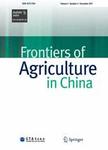版权所有:内蒙古大学图书馆 技术提供:维普资讯• 智图
内蒙古自治区呼和浩特市赛罕区大学西街235号 邮编: 010021

作者机构:College of Agronomy Agricultural University ofHebei Baoding 071001 China Administration Office of Science and Technologv Agricultural University of Hebei. Baoding 071001 China College of Resource and Environment Agricultural University of Hebei Baoding 071001 China
出 版 物:《中国农学前沿》 (Frontiers of Agriculture in China)
年 卷 期:2011年第5卷第3期
页 面:253-261页
基 金:This research was supported by the National Natural Science Foundation of China(Grant 30971773) the Natural Science Foundation of Hebei(C2008000325) the Key Crop Growth and Regulation Laboratory of Hebei
主 题:wheat (Triticum aestivum L.) chromosome substitution line nitrogen efficiency phosphorus efficiency potassiumefficiency plant growth trait photosynthetic parameter
摘 要:A complete set of chromosome substitution lines with genetic background of Chinese Spring (CS) were used to determine the effects of each chromosome on utilization efficiencies of nitrogen, phosphorus, and potassium in wheat (Triticum aestivum L.). In each line, only one pair of chromosomes in CS genome was substituted by the corresponding one of donor Synthetic 6x. Under normal growth conditions supplied with enough inorganic nutrients, the dry mass per plant and the utilization efficiencies of nitrogen (N), phosphorus (P), and potassium (K) in plants varied largely among CS, Synthetic 6x, and the chromosome substitution lines (1A–7A, 1B–7B, and 1D–7D). Of these, 1A substituted by the chromosome 1A of Synthetic 6x (other lines are the same as 1A hereafter) had the highest plant dry mass and the accumulative amount of N and K, and 1B behaved to have the highest plant accumulative P amount. 1D and 4D had the lowest accumulative P amount and plant dry mass, respectively. 4B showed the lowest plant accumulative N and K. Thus, chromosome 1A of Synthetic 6x contains major genes endowing plant capacities of higher dry mass, accumulative N and K, whereas chromosome 1B of Synthetic 6x carries major genes improving plant accumulative P capacities. The lines, together with CS and the donor, could be classified into three groups including high-efficiency, mid-efficiency, and low-efficiency based on plant dry mass. Regression analysis suggested that there are significantly positive correlations between plant dry mass and the accumulated amount of N, P, and K. Further, there are positively significant correlations among the plant accumulative N amount and some plant traits and physiological parameters, as well as positively significant correlations between the accumulative amount of P and K and the photosynthetic rate (P n).